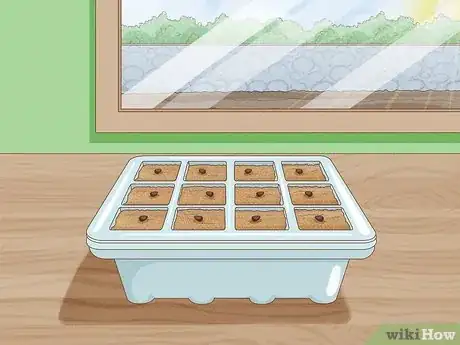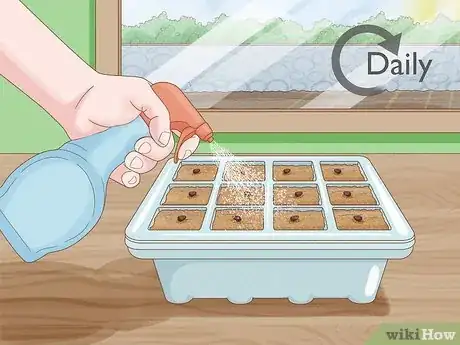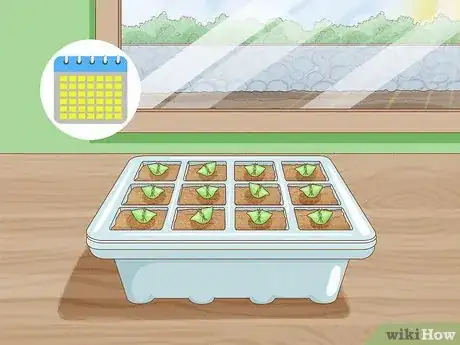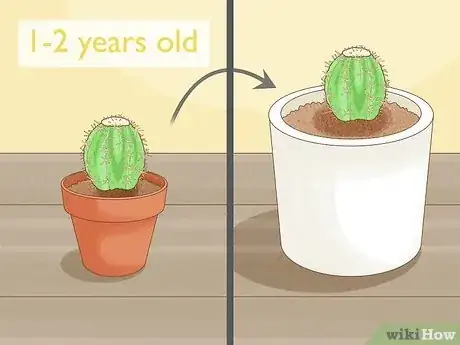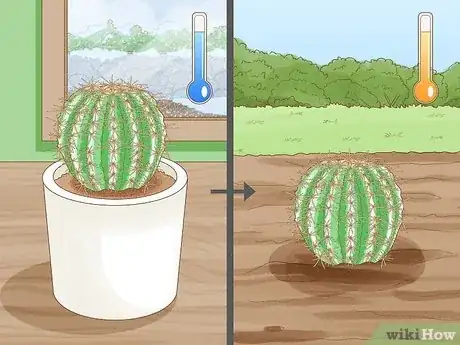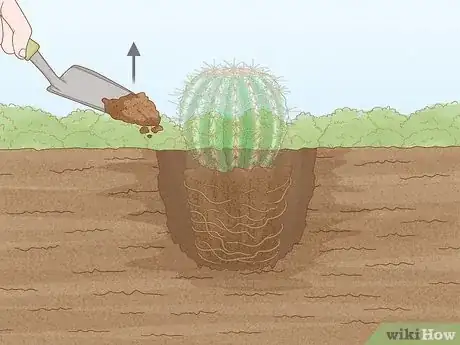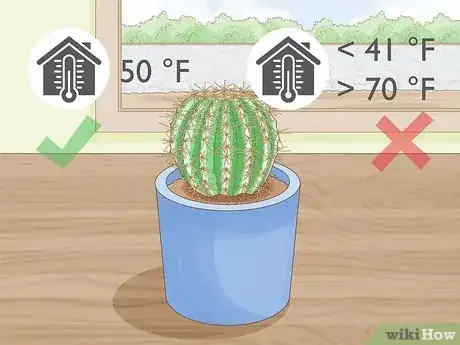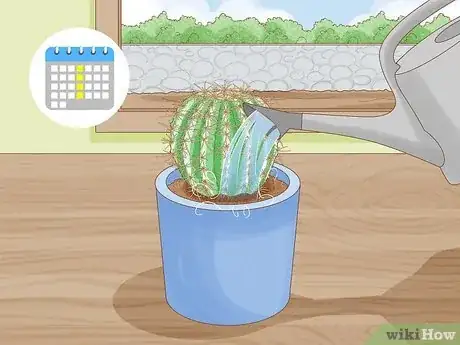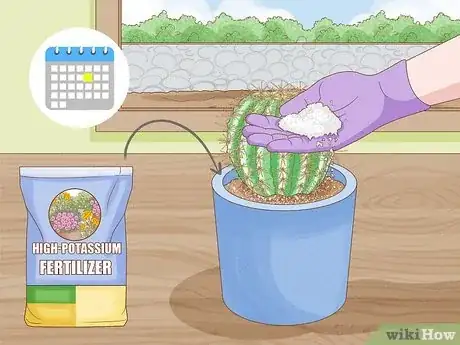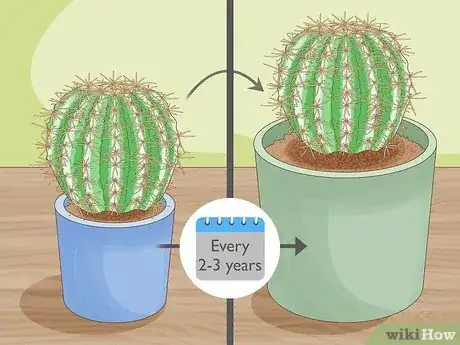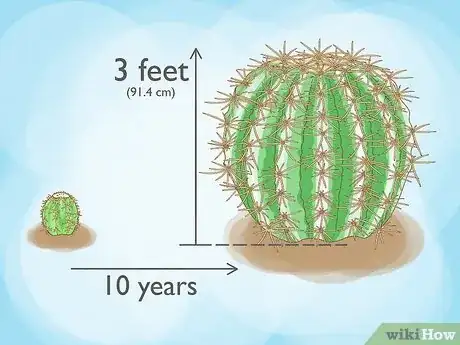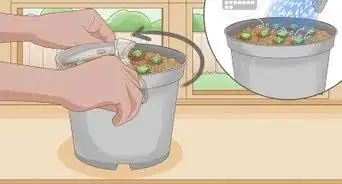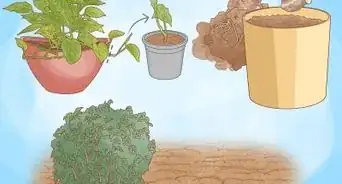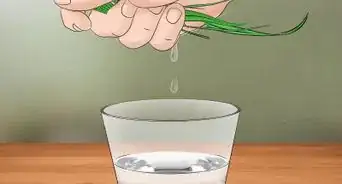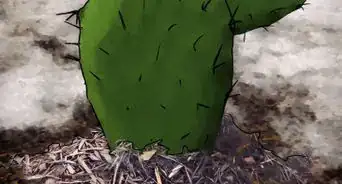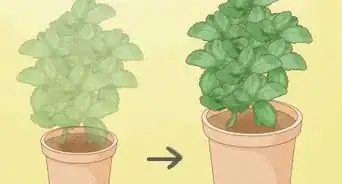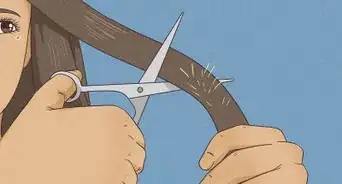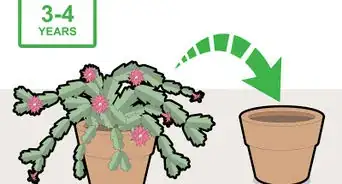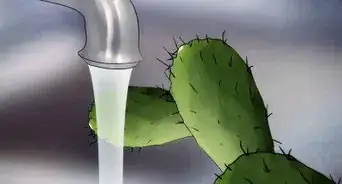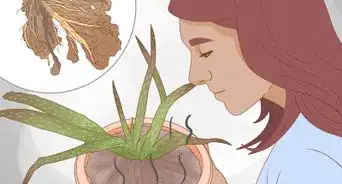This article was co-authored by Lauren Kurtz and by wikiHow staff writer, Kyle Hall. Lauren Kurtz is a Naturalist and Horticultural Specialist. Lauren has worked for Aurora, Colorado managing the Water-Wise Garden at Aurora Municipal Center for the Water Conservation Department. She earned a BA in Environmental and Sustainability Studies from Western Michigan University in 2014.
There are 10 references cited in this article, which can be found at the bottom of the page.
wikiHow marks an article as reader-approved once it receives enough positive feedback. This article received 11 testimonials and 100% of readers who voted found it helpful, earning it our reader-approved status.
This article has been viewed 140,005 times.
If you love plants, you’ll definitely love the golden barrel cactus. Also known as Echinocactus grusonii, these round plants are endangered in the wild but make popular staples in households with their beautiful yellow flowers. We’re here to teach you how to grow your own golden barrel cactus at home. Read on to learn about everything you’ll need to care for your cacti properly.
Steps
Planting Cactus Seeds
-
1Get golden barrel cactus seeds. Order the seeds online or visit your local gardening store.
-
2Plant the seeds in a seed tray. Use a potting mixture of half sand and half peat moss or potting soil. Fill up each compartment of the seed tray halfway with the potting mixture and then place a few seeds in each compartment. Cover the seeds with a layer of the potting mixture.[1]Advertisement
-
3Put the tray of seeds in filtered sunlight. Filtered sunlight is just non-direct sunlight, so any bright area will work.[2]
-
4Check on the seeds daily to make sure the soil doesn’t dry out. Lightly water the seeds to keep the soil moist.[3]
-
5Wait 2 to 6 weeks for the cactus seeds to germinate. The seeds will look like red spheres once they’re germinated.[4]
-
6Transfer the tiny cacti to 2 inch (5 cm) pots once they develop spines. Spines are the sharp, prickly parts of the cactus. Use tweezers to help with the transferring process. Plant the cacti in the same soil mixture you planted the seeds in. Wait one week to water the cacti after transferring them.[5]
-
7Let the cacti grow for 1 to 2 years before re-potting them. After that time, re-pot the cacti in pots that are one size larger than the pots they’re currently in. Gently pull the cacti out of their old pots and place them in their new pots, packing a soil mixture into the extra space around the roots. Water the re-potted cacti whenever the soil is dry, about once a week.[6]
- Always wear thick leather gloves when re-potting a cactus to protect yourself from the spines.[7]
-
8Choose whether you want your cacti to be indoor or outdoor plants. Now that the cacti are mature, you can plant them in soil outside, or leave them in pots indoors. There are a few things to keep in mind when you’re deciding:
Transplanting Your Cacti Outside
-
1Plant your cacti in a spot that gets a lot of direct sunlight. A spot that receives full sunlight all day long is ideal unless you live in an area with extremely hot temperatures. In that case, plant your cacti in a spot that gets half direct sunlight and half shade throughout the day.[10]
-
2Dig shallow holes so the spiny parts of the cacti are fully above ground. Only the roots of the cacti should fit in the holes. Use your hands or a small shovel to dig the holes.[11]
-
3Remove the cacti from their pots and loosen the soil around the roots. Use your fingers to rub off some soil from the sides and bottom of the roots. This will help the roots grow into the soil in the ground. Make sure you’re wearing thick leather gloves when you’re handling the cacti.[12]
-
4Plant the cacti in the holes. Make sure they’re not leaning to one side or they will continue to grow that way. Fill in the holes with the soil you dug up, packing down the soil around each cactus so it’s firm.[13]
Caring for Your Cacti
-
1Keep your cacti in direct sunlight. For indoor cacti, keep them near a window where they will receive direct sunlight from outside. For outdoor cacti, plant them in an area where there is full sun.[14]
-
2Keep your cacti in an area that is room-temperature if they're indoors. Room-temperature will be fine until winter arrives, when you’ll need to give your cacti a “resting period.” During winter keep your cacti in an area that is around 50 degrees Fahrenheit (10 degrees Celsius). Do not expose your cacti to temperatures below 41 degrees Fahrenheit (5 degrees Celsius) or above 70 degrees Fahrenheit (12 degrees Celsius) during the resting period.[15]
-
3Water your cacti whenever the soil gets dry, about once a week. This goes for both indoor and outdoor cacti. During the winter, water them less, about twice a month. This will prevent the roots from rotting.[16]
- Avoid wetting the bodies of your cacti when they're in direct sunlight to prevent sunburn. Water the soil surrounding your cacti instead.[17]
-
4
-
5
-
6Be patient with your cacti. The golden barrel cactus grows rapidly during the first couple of years after being planted, but it starts to slow down after that. It could take over a decade for your cacti to reach full size (some golden barrel cacti grow to be 3 feet (91.4 cm) wide!) so be prepared to tend to your new cacti for a long time.[22]
Expert Q&A
-
QuestionHow does a barrel cactus survive in the desert?
 Lauren KurtzLauren Kurtz is a Naturalist and Horticultural Specialist. Lauren has worked for Aurora, Colorado managing the Water-Wise Garden at Aurora Municipal Center for the Water Conservation Department. She earned a BA in Environmental and Sustainability Studies from Western Michigan University in 2014.
Lauren KurtzLauren Kurtz is a Naturalist and Horticultural Specialist. Lauren has worked for Aurora, Colorado managing the Water-Wise Garden at Aurora Municipal Center for the Water Conservation Department. She earned a BA in Environmental and Sustainability Studies from Western Michigan University in 2014.
Professional Gardener The barrel cactus is adapted to desert conditions including little water, extreme heat, cold nights, sandy soil, etc. It stores water in its cells and grows very slowly.
The barrel cactus is adapted to desert conditions including little water, extreme heat, cold nights, sandy soil, etc. It stores water in its cells and grows very slowly. -
QuestionHow much cold can the golden barrel cactus take?
 Lauren KurtzLauren Kurtz is a Naturalist and Horticultural Specialist. Lauren has worked for Aurora, Colorado managing the Water-Wise Garden at Aurora Municipal Center for the Water Conservation Department. She earned a BA in Environmental and Sustainability Studies from Western Michigan University in 2014.
Lauren KurtzLauren Kurtz is a Naturalist and Horticultural Specialist. Lauren has worked for Aurora, Colorado managing the Water-Wise Garden at Aurora Municipal Center for the Water Conservation Department. She earned a BA in Environmental and Sustainability Studies from Western Michigan University in 2014.
Professional Gardener During the growth period, keep the temperature between 61-75°F. During the resting period, keep the temperature between 39-50°F. If you live in a cold area that freezes in the winter, plant your cactus indoors or bring it indoors during cold seasons
During the growth period, keep the temperature between 61-75°F. During the resting period, keep the temperature between 39-50°F. If you live in a cold area that freezes in the winter, plant your cactus indoors or bring it indoors during cold seasons -
QuestionHow can I remove a cluster of cacti from an older/mature plant so that I can transplant them?
 Lauren KurtzLauren Kurtz is a Naturalist and Horticultural Specialist. Lauren has worked for Aurora, Colorado managing the Water-Wise Garden at Aurora Municipal Center for the Water Conservation Department. She earned a BA in Environmental and Sustainability Studies from Western Michigan University in 2014.
Lauren KurtzLauren Kurtz is a Naturalist and Horticultural Specialist. Lauren has worked for Aurora, Colorado managing the Water-Wise Garden at Aurora Municipal Center for the Water Conservation Department. She earned a BA in Environmental and Sustainability Studies from Western Michigan University in 2014.
Professional Gardener Dig up the cluster you want to remove with a small shovel or your hands (wear appropriate gloves to avoid getting poked with the spines). If the older cactus comes with the younger cluster, just place it back in the whole. Gently untangle young plant's roots from the older mature plant's roots. Transplant in desired spot or pot.
Dig up the cluster you want to remove with a small shovel or your hands (wear appropriate gloves to avoid getting poked with the spines). If the older cactus comes with the younger cluster, just place it back in the whole. Gently untangle young plant's roots from the older mature plant's roots. Transplant in desired spot or pot.
Warnings
- The spines on the golden barrel cactus are extremely sharp. Always wear thick gloves when handling your cacti.[23]⧼thumbs_response⧽
References
- ↑ http://worldofsucculents.com/grow-golden-barrel-cactus-seed/
- ↑ http://www.plantsrescue.com/tag/golden-barrel-cactus/
- ↑ http://www.plantsrescue.com/tag/golden-barrel-cactus/
- ↑ http://www.plantsrescue.com/tag/golden-barrel-cactus/
- ↑ http://www.plantsrescue.com/tag/golden-barrel-cactus/
- ↑ http://www.bbc.co.uk/gardening/basics/techniques/houseplants_cactus1.shtml
- ↑ http://www.bbc.co.uk/gardening/basics/techniques/houseplants_cactus1.shtml
- ↑ http://www.plantsrescue.com/tag/golden-barrel-cactus/
- ↑ http://www.plantsrescue.com/tag/golden-barrel-cactus/
- ↑ http://www.plantsrescue.com/tag/golden-barrel-cactus/
- ↑ https://www.youtube.com/watch?v=zf1F5J_SBsA&feature=youtu.be&t=19
- ↑ https://www.youtube.com/watch?v=zf1F5J_SBsA&feature=youtu.be&t=99
- ↑ https://www.youtube.com/watch?v=zf1F5J_SBsA&feature=youtu.be&t=146
- ↑ http://www.plantsrescue.com/tag/golden-barrel-cactus/
- ↑ http://www.plantsrescue.com/tag/golden-barrel-cactus/
- ↑ http://articles.latimes.com/2013/oct/01/news/la-lh-golden-barrel-cactus-20130925
- ↑ http://www.plantsrescue.com/tag/golden-barrel-cactus/
- ↑ http://www.bbc.co.uk/gardening/plants/plant_finder/plant_pages/3830.shtml
- ↑ http://www.bbc.co.uk/gardening/basics/techniques/soil_feedingplants1.shtml
- ↑ https://www.houseplantsexpert.com/golden-barrel-cactus.html
- ↑ http://www.plantsrescue.com/tag/golden-barrel-cactus/
- ↑ http://www.bbc.co.uk/gardening/plants/plant_finder/plant_pages/3830.shtml
- ↑ http://articles.latimes.com/2013/oct/01/news/la-lh-golden-barrel-cactus-20130925


